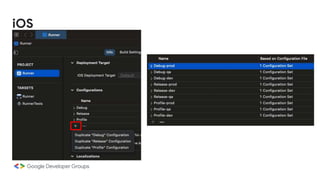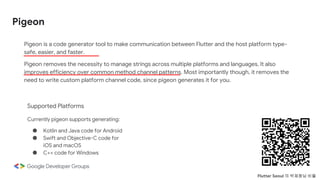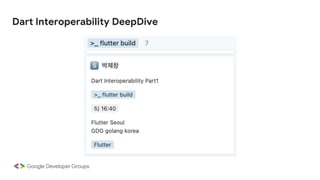2023 GDG Sondo DevFest - Flutter/ Flavor, PlatformChannel, Environment variable .pptx
- 1. 주니어 개발자의 배포일지 PlatformChannel & Flavor , Environment Variables을 알아보고 빌드 세팅을 해보자 Incheon/Songdo 김마로
- 2. 발표자 소개 자바(Spring) -> Flutter 모비어스 TMS (Transportation Management System) 개발자 LinkedIn
- 3. 목차 1. Flavor 2. Platform-Channel 3. Environment variables 4. pipeline 5. +@ In-House Deployment
- 4. Flavor
- 5. Flavor 란? 안드로이드의 Flavor, iOS의 configuration,scheme 과 같은 기능 간단하게 표현을 한다면 하나의 프로젝트 소스를 n개의 앱으로 “분리" 시켜 준다.
- 6. 앱을 왜 분리해야할까? 제일 큰 이유는 ● 동일한 코드 베이스를 유지 ● 개발,QA,운영(무료버전,유료버전)과 같은 환경분리(ex. Api EndPoint), ● 효율적인 개발 및 테스트 Flavor가 없었다면…..
- 7. DEV QA PROD QA PROD DEV APP QA APP PROD APP DEV APP 어느게 더 안전해보이는가?
- 11. iOS
- 12. iOS
- 13. iOS
- 14. iOS
- 15. iOS
- 16. iOS
- 17. iOS Platform-Channel 을 이 용하여 가지고 올 예정
- 18. iOS
- 19. +@Firebase
- 20. +@Firebase
- 21. Script if [ "${CONFIGURATION}" == "Debug-prod" ] || [ "${CONFIGURATION}" == "Release-prod" ] || [ "${CONFIGURATION}" == "Profile-prod" ]; then cp -r "${PROJECT_DIR}/Runner/firebase/prod/GoogleService-Info.plist" "${PROJECT_DIR}/Runner/GoogleService-Info.plist" elif [ "${CONFIGURATION}" == "Debug-qa" ] || [ "${CONFIGURATION}" == "Release-qa" ] || [ "${CONFIGURATION}" == "Profile-qa" ]; then cp -r "${PROJECT_DIR}/Runner/firebase/qa/GoogleService-Info.plist" "${PROJECT_DIR}/Runner/GoogleService-Info.plist" elif [ "${CONFIGURATION}" == "Debug-dev" ] || [ "${CONFIGURATION}" == "Release-dev" ] || [ "${CONFIGURATION}" == "Profile-dev" ]; then cp -r "${PROJECT_DIR}/Runner/firebase/dev/GoogleService-Info.plist" "${PROJECT_DIR}/Runner/GoogleService-Info.plist" fi
- 22. +@Firebase Flavor 에 맞게끔 FirebaseOptions를 넣어주면 끝.
- 23. Tip Flavor를 세팅을 하고 나면 실행시 마다 flavor를 지정해주어야 하기 때문에 main의 실행버튼을 쓸 수 없기에 터미널에서 직접 입력을 필요. Vscode나 AndroidStudio에서 해당 부분을 간편 하게 할수 있게 세팅시 편하게 실행 가능
- 24. Platform-Channel
- 25. 어…. 이건 Dart가 아닌데..?
- 27. Platform-Channel 이란? Platform-Channel ● (Binary Messaging) ● BasicMessageChannel ● MethodChannel ● EventChannel Flutter <-> Native 통신 기능
- 28. Binary messaging
- 30. BasicMessageChannel ● Binary Messaging + Codec ● 비동기
- 31. MethodChannel
- 32. MethodChannel ● Method 호출/응답 ● Argument 전달 ● 기본 코덱설정 ● 비동기
- 33. EventChannel
- 34. PubDev 의 Libraries 1. Geolocator 2. Camera 3. AudioPlayers 4. In_App_purchase 5. Battery_plus 6. … 7. … 8. … 9. …
- 35. 왜 Channel 인가? 수많은 네이티브 기능들.. 알림, 딥링크, 센서, 카메라, 배터리, 위치, 사운드, 커넥션, 다 른앱과 정보공유, 다른앱 실행,로컬 스토리지 등등… 플랫폼이 시간이 지날수록 추가되는 각종 신규 기능들을 어떻게 다 빠르게 지원할 수 있을까?
- 36. 플랫폼 채널 데이터 유형
- 37. Flutter ● Method-Channel 로 Flavor 가져오기 ● Flavor에 맞게끔 서비스환경 세팅
- 42. Flutter ● Method-Channel 로 Flavor 가져오기 ● Flavor에 맞게끔 서비스환경 세팅
- 45. 만약 더 제대로 써보고싶다면..? - 나는 플랫폼의 네이티브 기능들을 많이 사용해야 한다. - 모든 플랫폼에 각각 채널코드를 일일히 짜기가 너무 힘들다. - 뭔가 편한 방법이 없을까?
- 46. 비둘기 - 역사적으로 검증된 가장 오래된 통신 수단 (a.k.a 전서구) - 우리들에게 매우 친숙함 - 수명도 긴편 (10년~20년)
- 47. Pigeon Flutter Seoul 의 박제창님 비둘
- 48. Pigeon Pigeon is a code generator tool to make communication between Flutter and the host platform type- safe, easier, and faster. Pigeon removes the necessity to manage strings across multiple platforms and languages. It also improves efficiency over common method channel patterns. Most importantly though, it removes the need to write custom platform channel code, since pigeon generates it for you. Supported Platforms Currently pigeon supports generating: ● Kotlin and Java code for Android ● Swift and Objective-C code for iOS and macOS ● C++ code for Windows Flutter Seoul 의 박제창님 비둘
- 50. Pigeon @HostApi - Flutter 에서 Native 호출 @FlutterApi - Native 에서 Flutter 호출
- 51. 이걸로는 부족하다
- 52. FFIgen(Foreign Function Interface generator)
- 53. (Foreign Function Interface generator)
- 54. JNIgen (Java Native Interface generator )
- 55. How it works?
- 60. Way to set Flutter environment variables - .env (feat. flutter_dotenv) - --dart-define - --dart-define-from-file
- 61. --Dart-Define - Dart 에서 제공하는 환경변수를 설정해주는 커맨드라인 옵션 (Compilation environment declarations) - 예.) API end-point, logging level 등등
- 62. How to use? - command-line 에 빌드시 --dart-define=<NAME>=<VALUE> 추가 - fromEnvironment - hasEnvironment
- 63. Flutter 3.7.0 update - 3.7.0 부터는 json file로 여러 값들을 넣어서 호출할수 있도록 기능을 추가 - --dart-define-from-file = <filepath>
- 64. how to use
- 65. set up your pipeline
- 66. CI/CD - CI (Continuous Integration) - Build, Test - CD (Continuous Deployment) - Deploy
- 67. 다 알아야 할까?
- 68. Trigger Stage pool job task Android End task * n ubuntu Pipeline Flow task task N * task main-branch pool job task task task N * task iOS macOS task * n Prod,Qa,Dev Prod,Qa,Dev .apk .aab .ipa
- 69. Task - task: FlutterBuild@0 displayName: Build dev-fest-main inputs: target: apk projectDirectory: $(Build.SourcesDirectory)/dev-fest-main buildFlavour : prod extraArgs: >- --release --dart-define=SAFETY_CHECK=true - task: FlutterBuild@0 displayName: Build dev-fest-main inputs: target: ipa projectDirectory: $(Build.SourcesDirectory)/dev-fest-main extraArgs: >- --release --flavor=prod --dart-define=SAFETY_CHECK=true exportOptionsPlist: $(exportOptionsPlistPath)
- 70. 정리 1. 앱을 분리 한다 -> Flavor 1. 네이티브 코드를 적용해야한다 -> Plaform-Channel 1. 환경변수를 세팅해야한다 -> Dart-define 1. 빌드시 extraArg 에 Flavor, dart-define 을 넣어 주고 세팅완료
- 71. Thank you
- 73. iOS In-House Distribution - TestFlight - Ad-Hoc - Firebase App Distribution - 웹을 이용한 IPA 배포 (feat.Apple Developer Enterprise Program)
- 74. App Developer Enterprise Development - Have 100 or more employees. - Be a legal entity. We do not accept DBAs, fictitious businesses, trade names, or branches. - Use the program only to create proprietary, in-house apps for internal use, and to distribute these apps privately and securely to employees within the organization. - Have systems in place to ensure only employees can download your internal-use apps, and to protect membership credentials and assets. - Participate in and pass Apple’s verification interview and continuous evaluation process.
- 75. Unlisted App Distribution - 2022년 부터 제공한 비공개 AppStore 배포 - 엔터프라이즈 계정이 아닌 일반 개발자 계정으로도 배포가 가능 - 배포방식은 일반 스토어 배포와 동일하게 AppStoreConnect 에 심사 를 맡기지만 추가로 Unlisted App Distribution 이라는 배포 방식을 하 겠다고 description 란에 적어줘야함 - 또 별도의 Unlisted App Distribution 신청서를 작성
- 77. Thank you




















![Script
if [ "${CONFIGURATION}" == "Debug-prod" ] || [ "${CONFIGURATION}" == "Release-prod" ] ||
[ "${CONFIGURATION}" == "Profile-prod" ];
then
cp -r "${PROJECT_DIR}/Runner/firebase/prod/GoogleService-Info.plist"
"${PROJECT_DIR}/Runner/GoogleService-Info.plist"
elif [ "${CONFIGURATION}" == "Debug-qa" ] || [ "${CONFIGURATION}" == "Release-qa" ] ||
[ "${CONFIGURATION}" == "Profile-qa" ];
then
cp -r "${PROJECT_DIR}/Runner/firebase/qa/GoogleService-Info.plist"
"${PROJECT_DIR}/Runner/GoogleService-Info.plist"
elif [ "${CONFIGURATION}" == "Debug-dev" ] || [ "${CONFIGURATION}" == "Release-dev" ] ||
[ "${CONFIGURATION}" == "Profile-dev" ];
then
cp -r "${PROJECT_DIR}/Runner/firebase/dev/GoogleService-Info.plist"
"${PROJECT_DIR}/Runner/GoogleService-Info.plist"
fi](https://image.slidesharecdn.com/2023gdgsondodevfest-flutter-231211024435-98c7b3b8/85/2023-GDG-Sondo-DevFest-Flutter-Flavor-PlatformChannel-Environment-variable-pptx-21-320.jpg)




























































































![[232] 성능어디까지쥐어짜봤니 송태웅](https://cdn.slidesharecdn.com/ss_thumbnails/232-161025013504-thumbnail.jpg?width=560&fit=bounds)



![[아이펀팩토리]2017 NDC 강연 자료_아이펀 엔진 개발 노트](https://cdn.slidesharecdn.com/ss_thumbnails/20170426ndc17ver1-170428052244-thumbnail.jpg?width=560&fit=bounds)



![XECon2015 :: [2-1] 정광섭 - 처음 시작하는 laravel](https://cdn.slidesharecdn.com/ss_thumbnails/random-151116001443-lva1-app6892-2-160323043830-thumbnail.jpg?width=560&fit=bounds)

![[213]monitoringwithscouter 이건희](https://cdn.slidesharecdn.com/ss_thumbnails/213monitoringwithscouter-161025011551-thumbnail.jpg?width=560&fit=bounds)
![[AWS Dev Day] 실습워크샵 | Amplify 와 AI 서비스를 활용한 서버리스 기반 소셜 안드로이드 앱 만들기](https://cdn.slidesharecdn.com/ss_thumbnails/awsdevdayseoul2019hol41-190930092144-thumbnail.jpg?width=560&fit=bounds)